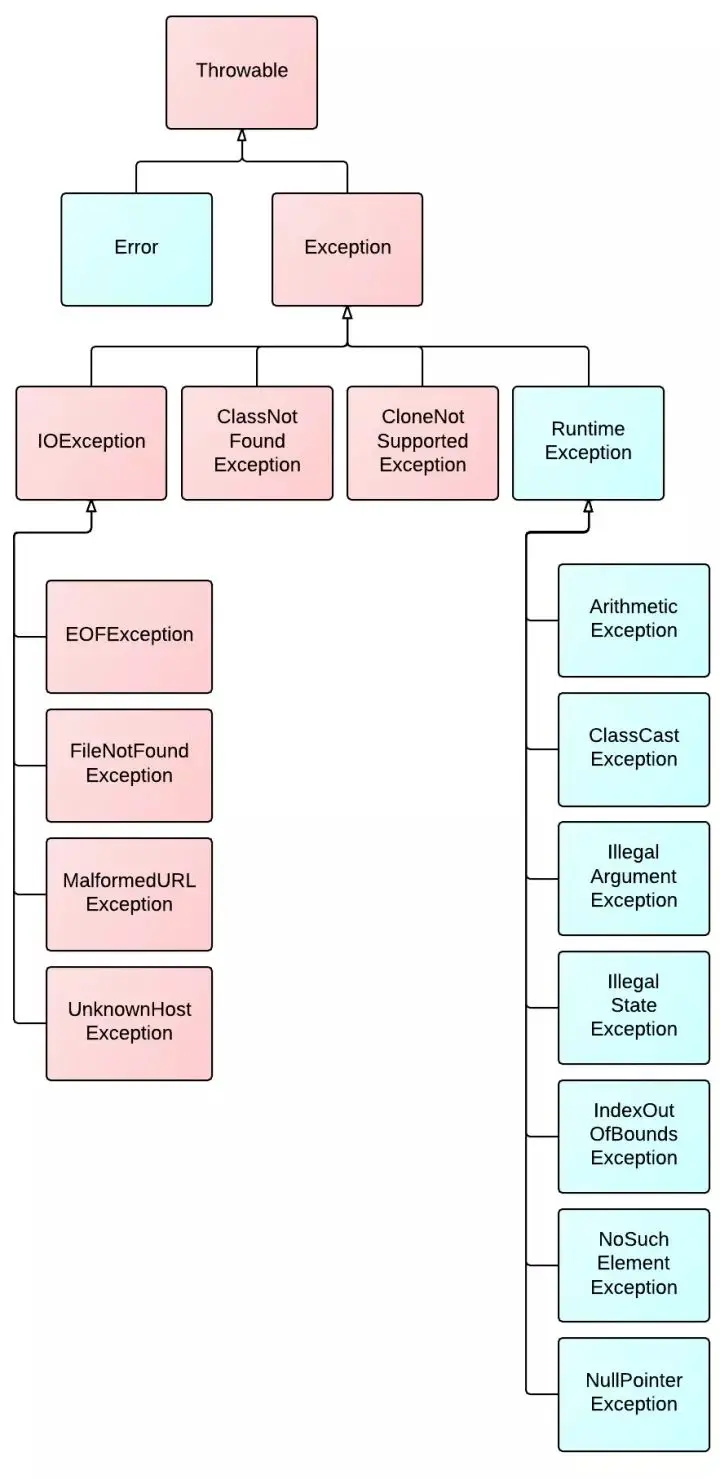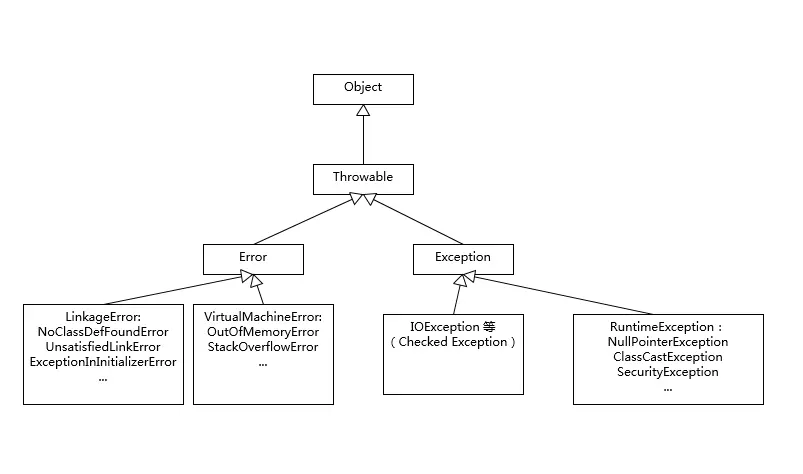概述
在运行的时候发生不正常的情况。在Java中采用类的形式对异常问题进行描述和封装对象。
对比Exception和Error
Exception 和 Error 都是继承了 Throwable 类,在 Java 中只有 Throwable 类型的实例才可以被抛出(throw)或者捕获(catch),它是异常处理机制的基本组成类型。
Exception 是程序正常运行中,可以预料的意外情况,可能并且应该被捕获,进行相应处理。
Error 是指在正常情况下,不大可能出现的情况,绝大部分的 Error 都会导致程序(比如 JVM 自身)处于非正常的、不可恢复状态。既然是非正常情况,所以不便于也不需要捕获,常 见的比如 OutOfMemoryError 之类,都是 Error 的子类。
Throwable中的常用方法:
- public void printStackTrace():打印异常的详细信息。包含了异常的类型,异常的原因,还包括异常出现的位置,在开发和调试阶段,都得使用printStackTrace。- public String getMessage():获取发生异常的原因。提示给用户的时候,就提示错误原因。- public String toString():获取异常的类型和异常描述信息(不用)。
异常分类
可检查(checked)异常
可检查异常在源代码里必须显式地进行捕获处理,这是编译期检查的一部分。前面介绍的不可查的 Error ,是 Throwable 不是 Exception 。
不检查 (unchecked)异常
不检查异常就是所谓的运行时异常,类似 NullPointerException ArrayIndexOutOfBoundsException之类,通常是可以编码避免的逻辑错误,具体根据需要来判断是否需要捕获,并不会在编译期强制要求。
try-catch代码段会产生额外的性能开销,或者换个角度说,它往往会影响JVM对代码进行优化,所以建议仅捕获有必要的代码段,尽量不要一个大的try包住整段的代码;与此同时,利用异常控制代码流程,也不是一个好主意,远比我们通常意义上的条件语句( if/else 、 switch )要低效。
Java每实例化一个Exception,都会对当时的栈进行快照,这是一个相对比较重的操作。如果发生的非常频繁,这个开销可就不能被忽略了。
所以,对于部分追求极致性能的底层类库,有种方式是尝试创建不进行栈快照的 Exception 。这本身也存在争议,因为这样做的假设在于,我创建异常时知道未来是否需要堆栈。问 题是,实际上可能吗?小范围或许可能,但是在大规模项目中,这么做可能不是个理智的选择。如果需要堆栈,但又没有收集这些信息,在复杂情况下,尤其是类似微服务这种分布 式系统,这会大大增加诊断的难度。
####常见异常
1、NullPointerException
空指针异常,操作一个 null 对象的方法或属性时会抛出这个异常。
public static void main(String[] args) {int[] arr = null;System.out.println(arr[1]);}
2、OutOfMemoryError
内存异常异常,这不是程序能控制的,是指要分配的对象的内存超出了当前最大的堆内存,需要调整堆内存大小(-Xmx)以及优化程序。
3、IOException
IO,即:input, output,我们在读写磁盘文件、网络内容的时候经常会生的一种异常,这种异常是受检查异常,需要进行手工捕获。
如文件读写会抛出 IOException:
public int read() throws IOExceptionpublic void write(int b) throws IOException
4、FileNotFoundException
文件找不到异常,如果文件不存在就会抛出这种异常。如定义输入输出文件流,文件不存在会报错,FileNotFoundException 其实是 IOException 的子类,同样是受检查异常,需要进行手工捕获。
5、ClassNotFoundException
类找不到异常,Java开发中经常遇到,是不是很绝望?这是在加载类的时候抛出来的,即在类路径下不能加载指定的类。看一个示例:
它是受检查异常,需要进行手工捕获。
6、ClassCastException
类转换异常,将一个不是该类的实例转换成这个类就会抛出这个异常。
如将一个数字强制转换成字符串就会报这个异常:
public static void main(String[] args) {Object a = 1;String s = (String) a;System.out.println(s);}
这是运行时异常,不需要手工捕获。
7、NoSuchMethodException
没有这个方法异常,一般发生在反射调用方法的时候
8、IndexOutOfBoundsException 越界异常
索引越界异常,当操作一个字符串或者数组的时候经常遇到的异常。
public static void main(String[] args) {int[] arr = {1,2,3,4};System.out.println(arr[4]);}
9、ArithmeticException
算术异常,发生在数字的算术运算时的异常,如一个数字除以 0 就会报这个错。
double n = 3 / 0;
10、SQLException
SQL异常,发生在操作数据库时的异常。
如下面的获取连接:
又或者是获取下一条记录的时候:
boolean next() throws SQLException;
异常处理
捕获异常
try…catch…finally
捕获异常语法格式如下,try和catch都不能单独使用,必须连用。finally是可选性
try{可能出现异常代码}catch(Exception e){处理异常的代码}finally{一定会执行的代码}
eg:
public static void main(String[] args) {try{int a = 2/0;}catch (ArithmeticException e){System.out.println("除数不能为0");}}
多个错误的处理
public static void main(String[] args) {try {int[] arr = {1,2,3,4};System.out.println(arr[4]);//ArrayIndexOutOfBoundsException数组越界异常int a = 2 / 0;//ArithmeticException:算术异常System.out.println(a);int[] arr1 = null;System.out.println(arr1[0]);//NullPointerException空指针} catch (ArrayIndexOutOfBoundsException e) {System.out.println("数组越界异常...");} catch (ArithmeticException e){System.out.println("算术异常...");} catch(NullPointerException e){System.out.println("空指针异常...");}}
多个异常通过|连接
try {} catch (ArrayIndexOutOfBoundsException |ArithmeticException | NullPointerException e) {System.out.println(e.getClass());}
finaly和return
public static void main(String[] args) {System.out.println(divFun(2,0));}public static int divFun(int a,int b){int result = 0;try {result = a/b;} catch (Exception e) {System.out.println(e.getClass());result = -1;return result;}finally {System.out.println("finally action");}return result;}
声明异常throws
使用throws声明的方法表示此方法不处理异常,抛给方法的调用者处理,用在方法声明后面,跟的是异常类名,可以跟多个异常类名,用逗号隔开。关键字throws运用于方法声明之上,用于表示当前方法不处理异常,而是提醒该方法的调用者来处理异常(抛出异常).
修饰符 返回值类型 方法名(参数) throws 异常类名1,异常类名2…{ }
eg
public static void main(String[] args) {try {System.out.println(divFun(2,0));}catch (Exception e){System.out.println(e);}}public static int divFun(int a,int b) throws ArithmeticException{int result = a/b;return result;}
它表示抛出异常,由该方法的调用者来处理
####抛出异常throw
用在方法体内,跟的是异常对象名,抛出的时候直接抛出异常类的实例对象。将这个异常对象传递到调用者处,并结束当前方法的执行。
throw new 异常类名(参数);
eg:
public static int divFun(int a, int b) {if (b == 0) {throw new ArithmeticException();}int result = a / b;return result;}
自定义异常
自定义异常直接继承Exception就可以完成自定义异常类
public static int divFun(int a, int b) throws ZeroException {if (b == 0) {throw new ZeroException("除数不能为0");}int result = a / b;return result;}class ZeroException extends Exception{public ZeroException(String message){super(message);}}

